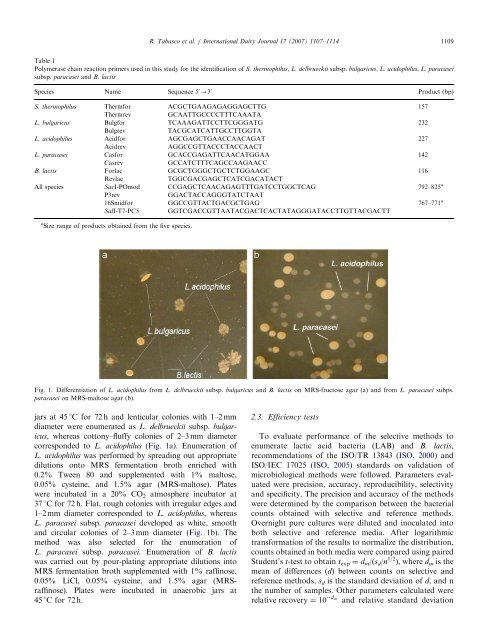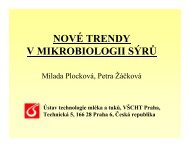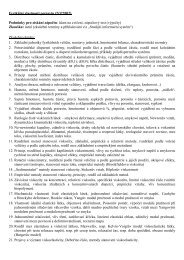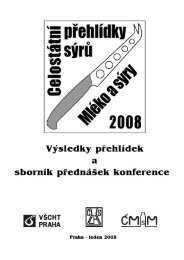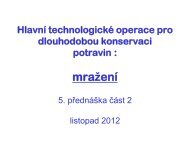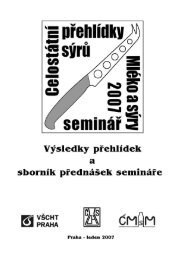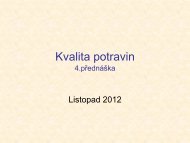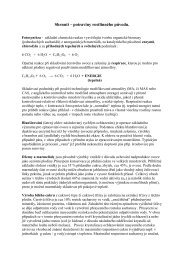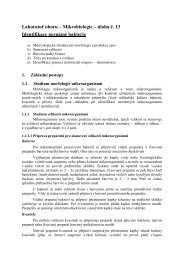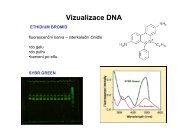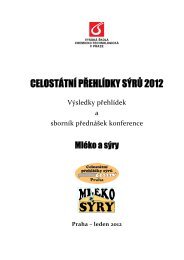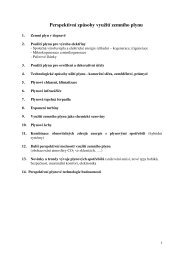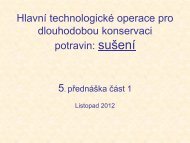Selective enumeration and identification of mixed cultures of ...
Selective enumeration and identification of mixed cultures of ...
Selective enumeration and identification of mixed cultures of ...
You also want an ePaper? Increase the reach of your titles
YUMPU automatically turns print PDFs into web optimized ePapers that Google loves.
jars at 45 1C for 72 h <strong>and</strong> lenticular colonies with 1–2 mm<br />
diameter were enumerated as L. delbrueckii subsp. bulgaricus,<br />
whereas cottony–fluffy colonies <strong>of</strong> 2–3 mm diameter<br />
corresponded to L. acidophilus (Fig. 1a). Enumeration <strong>of</strong><br />
L. acidophilus was performed by spreading out appropriate<br />
dilutions onto MRS fermentation broth enriched with<br />
0.2% Tween 80 <strong>and</strong> supplemented with 1% maltose,<br />
0.05% cysteine, <strong>and</strong> 1.5% agar (MRS-maltose). Plates<br />
were incubated in a 20% CO 2 atmosphere incubator at<br />
37 1C for 72 h. Flat, rough colonies with irregular edges <strong>and</strong><br />
1–2 mm diameter corresponded to L. acidophilus, whereas<br />
L. paracasei subsp. paracasei developed as white, smooth<br />
<strong>and</strong> circular colonies <strong>of</strong> 2–3 mm diameter (Fig. 1b). The<br />
method was also selected for the <strong>enumeration</strong> <strong>of</strong><br />
L. paracasei subsp. paracasei. Enumeration <strong>of</strong> B. lactis<br />
was carried out by pour-plating appropriate dilutions into<br />
MRS fermentation broth supplemented with 1% raffinose,<br />
0.05% LiCl, 0.05% cysteine, <strong>and</strong> 1.5% agar (MRSraffinose).<br />
Plates were incubated in anaerobic jars at<br />
45 1C for72h.<br />
ARTICLE IN PRESS<br />
Table 1<br />
Polymerase chain reaction primers used in this study for the <strong>identification</strong> <strong>of</strong> S. thermophilus, L. delbrueckii subsp. bulgaricus, L. acidophilus, L. paracasei<br />
subsp. paracasei <strong>and</strong> B. lactis<br />
Species Name Sequence 5 0 -3 0 Product (bp)<br />
S. thermophilus Thermfor ACGCTGAAGAGAGGAGCTTG 157<br />
Thermrev GCAATTGCCCCTTTCAAATA<br />
L. bulgaricus Bulgfor TCAAAGATTCCTTCGGGATG 232<br />
Bulgrev TACGCATCATTGCCTTGGTA<br />
L. acidophilus Acidfor AGCGAGCTGAACCAACAGAT 227<br />
Acidrev AGGCCGTTACCCTACCAACT<br />
L. paracasei Casfor GCACCGAGATTCAACATGGAA 142<br />
Casrev GCCATCTTTCAGCCAAGAACC<br />
B. lactis Forlac GCGCTGGGCTGCTCTGGAAGC 116<br />
Revlac TGGCGACGAGCTCATCGACATACT<br />
All species SacI-POmod CCGAGCTCAACAGAGTTTGATCCTGGCTCAG 792–825 a<br />
P3rev GGACTACCAGGGTATCTAAT<br />
16Smidfor GGCCGTTACTGACGCTGAG 767–771 a<br />
SalI-T7-PC5 GGTCGACCGTTAATACGACTCACTATAGGGATACCTTGTTACGACTT<br />
a Size range <strong>of</strong> products obtained from the five species.<br />
R. Tabasco et al. / International Dairy Journal 17 (2007) 1107–1114 1109<br />
Fig. 1. Differentiation <strong>of</strong> L. acidophilus from L. delbrueckii subsp. bulgaricus <strong>and</strong> B. lactis on MRS-fructose agar (a) <strong>and</strong> from L. paracasei subps.<br />
paracasei on MRS-maltose agar (b).<br />
2.3. Efficiency tests<br />
To evaluate performance <strong>of</strong> the selective methods to<br />
enumerate lactic acid bacteria (LAB) <strong>and</strong> B. lactis,<br />
recommendations <strong>of</strong> the ISO/TR 13843 (ISO, 2000) <strong>and</strong><br />
ISO/IEC 17025 (ISO, 2005) st<strong>and</strong>ards on validation <strong>of</strong><br />
microbiological methods were followed. Parameters evaluated<br />
were precision, accuracy, reproducibility, selectivity<br />
<strong>and</strong> specificity. The precision <strong>and</strong> accuracy <strong>of</strong> the methods<br />
were determined by the comparison between the bacterial<br />
counts obtained with selective <strong>and</strong> reference methods.<br />
Overnight pure <strong>cultures</strong> were diluted <strong>and</strong> inoculated into<br />
both selective <strong>and</strong> reference media. After logarithmic<br />
transformation <strong>of</strong> the results to normalize the distribution,<br />
counts obtained in both media were compared using paired<br />
Student’s t-test to obtain t exp ¼ d m/(s d/n 1/2 ), where d m is the<br />
mean <strong>of</strong> differences (d) between counts on selective <strong>and</strong><br />
reference methods, sd is the st<strong>and</strong>ard deviation <strong>of</strong> d, <strong>and</strong> n<br />
the number <strong>of</strong> samples. Other parameters calculated were<br />
relative recovery ¼ 10 dm <strong>and</strong> relative st<strong>and</strong>ard deviation


